
Welcome to the Club of Amsterdam Journal.
We see more and more examples of services as part of products. Thinking on services is hot. From service design to design thinking, taking a service as a central element in possible success of a product is adopted by many. But what is the next stage in this development. Will services become the dictators of our life. Will services shape our products?
An important development is the rise of service ecosystems. Services as the glue and fuel of connected touch points. Example of this evolution is the way our travelling in public transport transforms from a fare based experience into a subscription based experience. The virtual credit on the OVchipcard (Dutch public transport card) results in different kind of service, behavior and product experience.
These kinds of shifts will happen in all areas. The way we move to a service dominate economy will influence the way we consume, we behave and the way products and services itself will be shaped. In this session we look at these developments from different angles. – Iskander Smit, Strategy Director, Info.nl
…. and join us at the event about the future of the future of Services – Services as part of products – Thursday, 17 February!
Felix Bopp, editor-in-chief
Socratic Innovation

By Humberto Schwab, Philosopher
Director, Club of Amsterdam
Innovation is on the lips of all strategic leaders and all not-strategic leaders. If we look back at the figures worldwide about the increase of Internet connections and the increase of mobile phone connections, even in Africa or Latin America; we know innovation is not any longer something you can do or something you chose. If you do not innovate you will run out of business, unless you have good traditional craftsmanship products. One thing is four sure: in our hyper-fast information driven world, good traditional values are cornerstones of trust. For all the other stuff we must be continuously focused on the sustainability and effectiveness of our client approaches.
It is not that products and services are changing rapidly, it is the fact that they can be reached in complete new ways, that they can be produced in complete new ways and that the information about these facts uses new ways. These factors can change the character of product.
The techniques of making products ors services are most of the time creations of intelligent designers dealing with visions and imagination on the one hand and technical limitations to that vision and imagination on the other hand.
Products and services are answers to real needs or desires of people like you and me or are strong new imaginations of new human needs or experiences, or put in another way are incentives for new needs and desire. All these new and old desires and needs are part of the rich “human experience”.
The discussion is of course always legitimate about the question; if a certain product, services or (nowadays) application factually serves a real need, an authentic need or ultimately a good need. This debate is ongoing since Plato.
The desire to smoke cigarettes was a strong need, probably generated and in any way enhanced by the “Dandy” culture of the “roaring twenties”. The culture nestled this need in the hearts and minds of the people. I myself was really in need of cigarettes during almost twenty year. It was not an authentic need but it connected with a body desire, evoked and at the same time satisfied by the nicotine!
The same holds for the television, which generated a need that did not exist before. Although you can say that we had visual needs and we – human creatures – have very strong visual reward systems in our neurological system. The television awakened a visual reward system that was potential present, but evoked and satisfied by the apparatus. It was not an authentic need, but it generated a strong desire and still does to a lot of people.
The wine we drink gives another strong example of another type of need; it is almost a natural desire that stems from our bodily statue. Yet its influence has increased the last decades. We drink more wine, we enjoy more qualities and the new ways of producing, transporting and valorization have even deepened our wine desire and the satisfaction that goes with it. If you are enjoying the wine, you praise the day that somebody taught you how to drink.
If we look for another need, our need to move, to transport ourselves, to travel; the change of the way of moving from horse riding to flying with planes, is paramount.
The human desire is not originally aimed at flying, but it s existence is a perfect match on the cultural and physical needs we have. We want to move on, like nomads and we want to settle down, both genetic engraved drivers that constitute our system. Any innovation of the experience of traveling can count on these inclinations. You can travel fast to exotic places, but you want to feel at settled.
All the examples are nice from the perspective of the contraposition between real needs and artificial needs, or as Rousseau would put it between human needs and alienated needs.
But we might state that almost all our newly created desires are aimed at enriching the human experience, to give daily life experiences more dimension or more quality. Or to say it in another way, it tries to boost the human development, the emancipation to richer forms of life. The question is always did this or that innovation really reached that? We can bluntly mistake ourselves in the value of innovations.
Also we can see that – although bad for our physical and mental health – they all connect with real authentic needs in one way or another. We can sometimes say they are not intelligent connected with our rudimental needs. The smoking is a good example. The destroying of nature in all aspects is quite unintelligent, but as soon as we get awareness of the stupidity of the so-called innovation of human experiences, we will eventually stop it (although sometimes late or too late). But the process of eliminating the value of smoking is unheard. Governments have really innovated their way of dealing with health issues.
Here is where innovation start, innovation is mostly connected with changing old products and services into new varieties or into better qualities of higher level. But if we look at the examples, we can easily say that innovation has to do with the way we create our needs and the way we validate our way of satisfactions.
The reconsidering of the coolness of smoking into coolness without smoking is an innovation of the concept “cool”. The same way holds for driving cars: the Prius experience and not BMW one, we innovate the car production lines, but Toyota also innovated our value of the car experience. The noise producing gasoline cars were also creating the value of being heard by everyone in the street, the technical limitations gave form to the product. There were not a few people, who love to hear the sound of noisy gasoline engines!
Nowadays all the car experience is about not being heard outside the car and listening to super hi-fi stereo!
Driving in your hybrid car is a very satisfying and tranquilizing experience.
We want to eat well; we want to eat slowly (after decennia of fast food desires) so we innovate our eating experiences. We want to buy clothes that are made in a fair way, the same for coffee, chocolate etc. that really enriches our experiences.
Eating chocolate did not incorporate – till recently – the aspects of child labour or the suppression of other people. Some people really enjoyed the idea that slaves had worked for their products.
The way we inform, the way we make, and the way we design all innovated the chocolate experience.
So we innovate our parts or building elements of our daily human experiences and we probably practice an evolution in these innovations. Sometimes this evolution is an improvement and sometimes it is an impoverishment (or better put: an erroneous attempt to evolution), but always there is a intrinsic connection with elements of the human neurological and cultural “desire complex”. The goal of innovation – at least the intended one – is improvement of the human condition; an improvement of previous solutions, better solution to burning problems, a jump in the possibility of esthetic-cultural experiences or even the improvement of the concept of human experiences in general.
Of course comes on all these levels the critical question: what is a good innovation, or what are the criteria to measure the value of an innovation?
There are of course different forms of innovations: we just innovate the product, the service, the process, the producer- client relation, the price, the image, the marketing, the business concept or do we innovate the experience related to the original product? Some innovations were really small in the concept but huge in their output. When Ryan air realized that planes are flying machines that ought to be in the sky as much as possible, they drastically innovated the whole flight travel industry. This is fundamentally a “deep dive” reflection on what you really are doing, what your competence is or what your distinctive competence is.
Socratic Innovation
As we see that the scope and dimension of innovation are not or should not be limited, the methods to reach good innovations should be limitless in the creative sense. There are a lot of very expensive managerial systems to trigger innovation. These fixed systems do not serve because they were always constructed in the world preceding the innovation, they will always try the old paradigm to create new concepts, which is contradictory. Or at least it will ignore fissures in the old paradigm.
A real innovation strategy is one which incorporates paradigm switches from any levels. This can also mean a switch on the creation of human desire or human experience.
Steve Jobs: People are in no condition to know what the next star product will be.
Henry Ford: If I would have asked my clients what they wanted, they would have answered: a faster horse!
We have to be able to rethink all the aspects of the human experience with his or that product, service or application. Even old boundaries between separated domains, for example making phone calls and making photographs, should be “virtually” forgotten. To deal with such a demand we need the possibility of reframing completely old concepts, the only honest tool is the Socratic discourse method. It can make fruit of millions of ideas and concepts ever surged in whatever context, so in the domain of the rich Socratic context, every person gets back the chance of testing his or hers most strange, normal or personal idea. The total ocean of ideas is the most open domain to deliver creative open innovation. Every other discipline is stuck to its paradigm; the Socratic paradigm is that we can explore a lot of paradigms.
Most important of all, we have to realize that people are very context dependent; we continuously make the mistake of thinking in dispositions. People of such a background or such a personality will do this or that in whatever circumstances. Psychological investigation shows – over and over again- that the environment influences our inner world profoundly. If we want to create in an innovative way, we have to recreate our way of working or being together. The classical organization of a company is that of an industrial army.
Top down management, task-division, marketing, finance etc. There is a strong hierarchical line within the company; everybody is looking up to and “waiting for ” the management and – in some cases – with the backs positioned towards the client. The central fallacy of this system is that the higher you get the better the creative thinking occurs; that individuals have to create smart ideas. And that people have fixed roles in these hierarchies. This classical surrounding puts people in an isolated position. Talking to your staff will not catalyze at once creative collaborative thinking. In normal discussions people will stick to fixed roles and use the same power games over and over again, people with very bright ideas often have a lack of self confidence in articulating them, people who keep silent most of the time think more then people who easy talk; also hierarchical higher personalities taking more speaking time in the assumption that that is the best for everyone.
In the Socratic dialog, this is in a subtle way replaced by a process in which people do not discuss much, but listen more, take more empathic stands and are guided to a more “question oriented” approach then to a solution oriented approach. So the central organizer is the common shared question. Starting from common values we then organize a travel towards a possible answer, which is shared by all. The highest in hierarchy should be the one who can listen the best. A real Socratic governed organization has a leader who constantly knows to put the best question at any situation. Crafting the question is a discipline that can fortify communication processes. In general the Socratic method as a process catalyst, has a communicative power in making communities (comunicare). Even within old contexts the Socratic dialog creates an open innovative space where brains can connect and the hidden intelligence of all participants can be brought to light!
On the content side the Socratic method works as an icebreaker: it can open very fixed lines of thoughts. Breaking the ice is not only a rational process, the space you reach is also a emotional ad a psychological space; crucial for creative thinking.
To come to a really strong fundamental reflection on any thing; about energy, about security, about biking, about wine drinking, about moving or even about going to the lo, you have to rethink the simple concept in all its presumptions and assumptions. The detective work of examining the real impact of these concepts can lead to real innovations.
Every side step or idea or hesitation of some of the participants can lead to a new insight. To neutralize classical scientific barriers or classical abstract languages hurdles, the chair has to be a practical philosopher who is capable to oversee the whole language game of science and the connection with simple clear formulations. So you need trained academic philosophers prepared to the job. The automatic selection of sophisticated concepts or so endogen concepts can block a complete opening to new horizons. You can see this by realizing that our horizons are created by common sense concepts, we repeatedly use. So to create new horizons (which are new paradigms) we have to make new basic concepts.
These two ways (creating another context, using philosophical critical tools) make Socratic innovation a rich but complex tool for strong innovation. It transforms the company for one day in a collaborative think tank and the method is able to produce practical intelligence that is created by all in a hyper collaborative effort!
Summary
Socratic innovation can deliver “deep dives” at any depth! In Socratic innovation we go radically to the roots of our activities, our concepts and our fixed assumptions. The classical Socratic approach has four characteristics:
– Knowledge can be pursued, and can lead to an understanding of what is true
– The search for true knowledge is a co-operative enterprise
– Questioning is the primary form of education, drawing out true knowledge from within rather than imposing knowledge from outside.
– Knowledge must be pursued with a ruthless intellectual honesty. ((from Creative and Critical Thinking Vol 4.1, Robert Fisher, Brunel University, England)
You can see very clearly that these classical approaches are very relevant in our actual social driven society. With Socratic innovation you will go to the deep truth about your real capacity (also you will become very honest with your self), together with all your workers you will make an intelligent effort to develop practical knowledge that will help create new horizons. Finally it will be a value driven approach were the knowledge about the real scope of the experience is central. Furthermore there is no selling of a product: in dialog with your stakeholders AND clients you develop the new experiences. This is perfectly fitted to the world of social media in which collaboration, consumer intelligence, co-creation, shared intelligence and value sharing is crucial.’
Social media is content created by people using highly accessible and scalable publishing technologies. At its most basic sense, social media is a shift in how people discover, read and share news, information and content. It’s a set of technologies, tools and platforms facilitating the discovery, participation and sharing of content. It is transforming monologues (one to many) into dialogues (many to many) and the democratization of information, transforming people from content readers into publishers.” (Wikipedia)
It is no longer push we can exercise, you have to listen to your clients, talks with them ad then cooperate with them. You even have to invest into free exchange of information or knowledge that is valuable for your potential clients.
Most important is that you give truthful information, that you understand the needs of the client and that you can react in a personalized way. Furthermore you will engage in a sustainable dialog with your client in which you cannot hide secrets or at least have to be open. Then probably you will be joining hands in making products, services and application.
In the innovation methodology of Humberto Schwab there are different key elements built in one Socratic chain: Value creation. Appreciative inquiry. Socratic dialog and future scenarios.
Next Event

the future of Services
Services as part of products
Thursday, February 17, 2011
Registration: 18:30-19:00, Conference: 19:00-21:15
Location: Het Bethaniënklooster, Barndesteeg 6B, 1012 BV Amsterdam [Next to Nieuwmarkt]
The speakers and topics are
Pieter Jan Stappers, Professor, Chair of Design Techniques, TU Delft
Future of Services – Future for Designers?
Iskander Smit, Strategy Director, Info.nl
A future of impulse driven and hyper personalised services
Lorna Goulden, Lead Creative Director, Philips Design
Consequences of The Internet of Things from a design perspective
Daniel Erasmus, Owner, The DTN
Scenarios for a Society driven by Services
Moderated by Kwela Hermanns
Desert Greening
Permaculture in Landscape and Society
As the basis of permaculture is beneficial design, it can be added to all other ethical training and skills, and has the potential of taking a place in all human endeavors. In the broad landscape, however, permaculture concentrates on already-settled areas and agricultural lands. Almost all of these need drastic rehabilitation and re-thinking. One certain result of using our skills to integrate food supply and settlement, to catch water from our roof areas, and to place nearby a zone of fuel forest which receives wastes and supplies energy, will be to free most of the area of the globe for the rehabilitation of natural systems. These need never be looked upon as “of use to people”, except in the very broad sense of global health.
The real difference between a cultivated (designed) ecosystem, and a natural system is that the great majority of species (and biomass) in the cultivated ecology is intended for the use of humans or their livestock. We are only a small part of the total primeval or natural species assembly, and only a small part of its yields are directly available to us. But in our own gardens, almost every plant is selected to provide or support some direct yield for people. Household design relates principally to the needs of people; it is thus human-centered (anthropocentric).
This is a valid aim for settlement design, but we also need a nature-centered ethic for wilderness conservation. We cannot, however, do much for nature if we do not govern our greed, and if we do not supply our needs from our existing settlements. If we can achieve this aim, we can withdraw from much of the agricultural landscape, and allow natural systems to flourish.
Recycling of nutrients and energy in nature is a function of many species. In our gardens, it is our own responsibility to return wastes (via compost or mulch) to the soil and plants. We actively create soil in our gardens, whereas in nature many other species carry out that function. Around our homes we can catch water for garden use, but we rely on natural forested landscapes to provide the condenser leaves and clouds to keep rivers running with clean water, to maintain the global atmosphere, and to lock up our gaseous pollutants. Thus, even anthropocentric people would be well-advised to pay close attention to, and to assist in, conservation of existing forests and to assist in, the conservation of all existing species and allow them a place to live.
We have abused the land and laid waste to systems we never need have disturbed had we attended to our home gardens and settlements. If we need to state a set of ethics on natural systems, then let it be thus:
- Implacable and uncompromising opposition to further disturbance of any remaining natural forests, where most species are still in balance;
- rehabilitation of degraded and damaged natural systems to stable states;
- Establishment of plant systems for our own use on the least amount of land we can use for our existence; and
- Establishment of plant and animal refuges for rare or threatened species.
Permaculture as a design system deals primarily with the third statement above, but all people who act responsibly in fact subscribe to the first and second statements. We believe should use all the species we need or can find to use in our own settlement designs, providing they are not locally rampant and invasive.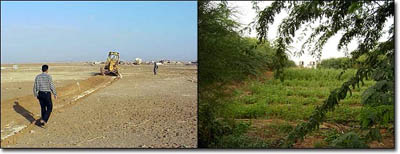
Before and after photos of previous Jordan project
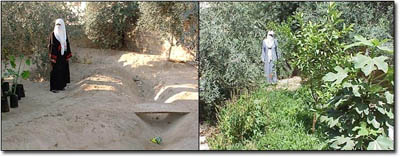
‘Greening the Desert – the Sequel’
When there’s no soil, no water, no shade, and where the sun beats down on you to the tune of over 50°C (122°F), the word ‘poverty’ begins to take on a whole new meaning. It is distinct and surreal. It’s a land of dust, flies, intense heat and almost complete dependency on supply lines outside of ones control. This is the remains of what was once called the ‘fertile crescent’. It is the result of thousands of years of abuse. It is a glimpse at a world where the environment – whose services provide for all human need – has all but completely abandoned us. This is a glimpse at the world our consumer society is inexorably moving towards, as our exponential-growth culture gorges itself at ever-increasing rates.
The original Greening the Desert video clip has been watched hundreds of thousands of times and has been posted to countless blogs and web pages in the datasphere. Although only five minutes long, it has inspired people around the globe, daring the lucid ones amongst us, those who can see the writing on the wall, to begin to hope and believe in an abundant future – a future where our survival doesn’t have to be based on undermining and depleting the very resources of soil, water, phosphorus, etc. that we depend on. The work profiled in that clip demonstrates that humanity can be a positive element within the biosphere. Man doesn’t have to destroy. Man can repair.
In the clip at top I introduce you today to Greening the Desert II. I shot the footage for this video last month (October 2009) and edited it on location in the Dead Sea Valley in Jordan – the lowest place on earth, at 400 metres below sea level. Much of it was shot in or near the village of Al Jawfa where I stayed, which is effectively a Palestinian refugee camp that has morphed over the decades since 1948 into something resembling a functional small town. It was first shown to delegates of the ninth International Permaculture Conference (IPC9) in Malawi, Africa at the very beginning of November and is now being released for general consumption. The video will take you to the original Greening the Desert site, letting you see its present condition after six years of neglect when funding ran out in 2003. You’ll also be introduced to our new project site – the Jordan Valley Permaculture Project, aka ‘Greening the Desert, the Sequel’ – and see some of the spin-off effects within Jordan from the influence of the original site; promises of much more to come.
The work we’re undertaking in Jordan is in accordance with what we call the ‘Permaculture Master Plan‘, where the project’s future is assured through funding from running educational courses. Project sites thus become self-sufficient, and self-replicating. Through this work we envision thousands of educational demonstration sites worldwide – all inspiring and teaching communities around them how to begin to tackle at root the massive challenges we now face after decades of short-term profit-based thinking has all but ‘consumed’ our planet and dismantled the social constructs that the human race has always depended on for its survival. Through this work we see desertification stopped in its tracks, and reversed. We see this century’s dire water issues getting resolved. We see productive work for millions in bypassing the irrelevant efforts of our ‘leaders’, to instead build a new kind of culture – a culture based on cooperative effort and learning. It’s a culture where its members have regained a sense of their place in creation, where they become land-based stewards of remaining resources; creating a culture where we at last find ultimate satisfaction – promoting and building peace and low-carbon, relocalised, community-based prosperity.
We have many such ‘Master Plan’ projects in various stages of development worldwide, and a steady stream of enquiries from people around the globe wanting to get involved and help widen this cooperative network. Perhaps it’s time you took a look at Permaculture? After all, do you have something more worthwhile to do?
.
The Personal Futures Workbook

by Verne Wheelwright
Exploring and preparing for your future
What is a personal future? As we interpret personal futures here, they are explorations of the potential futures of one individual, but only the futures that directly involve that individual. You will be learning about the futures that relate directly to you and your family.
What should you be able to expect from studying about your future? The approach you will take with this workbook consists of three steps:
1. Build a framework of information about your life.
2. From the framework information, explore your future with scenarios.
3. From the scenarios, develop a vision, strategies, and action plans for your future.
You will use the same methods that have been practiced by futurists for decades all over the world. At the end of this process you should have an overview and a vision for your life, specific plans for the next stage of life, and contingency plans to deal with unexpected changes.
Here are the steps that you will be following in this workbook as you prepare for your future:
Personal Research
Life stages
Personal domains and driving forces
Life events
Your plans, goals and values
Personal Scenarios
Develop a scenario matrix
Examine the driving forces in your life
Create four scenarios
Personal Strategic Planning
Create a vision for the next stage of your life.
Develop strategies
Develop action plans
Develop contingency plans
And the final step..… Live your plan!
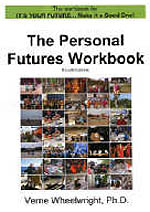
Club of Amsterdam blog

Club of Amsterdam blog
http://clubofamsterdam.blogspot.com
January 1: On the meaning of words
November 30: The happy organisation – a deontological theory of happiness
November 26: Utilitarianism for a broken future.
News about the Future

Europe can be marine biotech leader
The Marine Board of the European Science Foundation (ESF) says in its latest report that Europe can take the leading role in marine biotechnology by 2020. Latest data show that the marine biotechnology market is valued at EUR 2.8 billion, and has the potential to grow up to 12% each year if industry and academia cooperate. The ESF experts say Europe’s four seas and two oceans offer diverse conditions of temperature, pressure, light and chemistry, from shallow coastal waters to the deep ocean. The changes that allowed myriad marine organisms to thrive in these conditions led to a living library of diversity that is both unexplored and underexploited, the ESF’s Marine Board says. Marine biotechnologists can use these resources to develop new products and services, and in turn help bring solutions to the table as regards challenges that affect our planet, including offering a sustainable supply of food and energy and new industrial materials and processes, and developing new drugs and health treatments. ‘Marine biotechnology not only creates jobs and wealth, it can also contribute to the development of greener, smarter economies,’ explains Lars Horn of the Research Council of Norway and Chair of the Marine Board. ‘Japan, China and the US are already investing heavily in marine biotechnology. If we fail to act, Europe will lose out.’

Global Employment Trends 2011: The challenge of a jobs recovery
The annual Global Employment Trends (GET) report provides the latest global and regional estimates of employment and unemployment, employment by sector, vulnerable employment, labour productivity and working poverty, while also analysing country-level issues and trends in the labour market. Taking into account macroeconomic trends and forecasts, the GET includes a short-term outlook for labour markets around the world.
The report finds that there were around 40 million more working poor at the extreme US$ 1.25 level in 2009 than would have been expected in the absence of the global economic crisis. An estimated 630 million workers (one in five workers in the world) were living with their families at the extreme US$ 1.25 a day level in 2009. Globally, an estimated 1.53 billion workers were in vulnerable employment in 2009, which corresponds to a vulnerable employment rate of 50.1%.
European Values Study
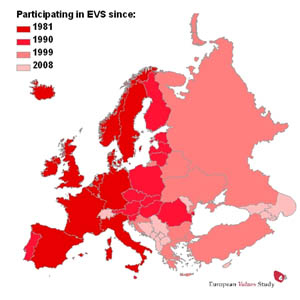
The European Values Study is a large-scale, cross-national, and longitudinal survey research program on basic human values. It provides insights into the ideas, beliefs, preferences, attitudes, values and opinions of citizens all over Europe. It is a unique research project on how Europeans think about life, family, work, religion, politics and society.
The European Values Study started in 1981, when a thousand citizens in the European Member States of that time were interviewed using standardized questionnaires. Every nine years, the survey is repeated in an increasing number of countries. The fourth wave in 2008 will cover no less than 47 European countries/regions, from Iceland to Azerbaijan and from Portugal to Norway. In total, about 70,000 people in Europe will be interviewed.
A rich academic literature has been created around the original and consecutive surveys and numerous other works have made use of the findings. In-depth analyses of the 1981, 1990 and 1999 findings with regard to Western and Central Europe, and North America reinforced the impression that a profound transformation of modern culture is taking place, although not at the same speed in all countries. Cultural and social changes appear dependent upon the stage of socio-economic development and historical factors specific to a given nation. The new 2008 wave will provide further insights in this matter.
Recommended Book
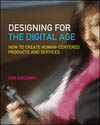
Designing for the Digital Age: How to Create Human-Centered Products and Services
By Kim Goodwin
Whether you’re designing consumer electronics, medical devices, enterprise Web apps, or new ways to check out at the supermarket, today’s digitally-enabled products and services provide both great opportunities to deliver compelling user experiences and great risks of driving your customers crazy with complicated, confusing technology.
Designing successful products and services in the digital age requires a multi-disciplinary team with expertise in interaction design, visual design, industrial design, and other disciplines. It also takes the ability to come up with the big ideas that make a desirable product or service, as well as the skill and perseverance to execute on the thousand small ideas that get your design into the hands of users. It requires expertise in project management, user research, and consensus-building. This comprehensive, full-color volume addresses all of these and more with detailed how-to information, real-life examples, and exercises. Topics include assembling a design team, planning and conducting user research, analyzing your data and turning it into personas, using scenarios to drive requirements definition and design, collaborating in design meetings, evaluating and iterating your design, and documenting finished design in a way that works for engineers and stakeholders alike.
Global Food and Farming Futures
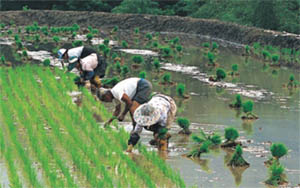
Global Food and Farming Futures
by the Government Office for Science, London
How can a future global population of 9 billion people all be fed healthily and sustainably?
The Foresight project Global Food and Farming Futures explores the increasing pressures on the global food system between now and 2050. The Report highlights the decisions that policy makers need to take today, and in the years ahead, to ensure that a global population rising to nine billion or more can be fed sustainably and equitably.
The Foresight report makes a compelling case for urgent action to redesign the global food system to meet the challenge of feeding the world over the next 40 years.
The Project analysed five key challenges for the future:
A. Balancing future demand and supply sustainably – to ensure that food supplies are affordable.
B. Ensuring that there is adequate stability in food prices – and protecting the most vulnerable from the volatility that does occur.
C. Achieving global access to food and ending hunger – this recognises that producing enough food in the world so that everyone can potentially be fed is not the same thing as ensuring food security for all.
D. Managing the contribution of the food system to the mitigation of climate change.
E. Maintaining biodiversity and ecosystem services while feeding the world. The Project has involved around 400 leading experts and stakeholders from about 35 countries across the world. Drawing upon over 100 peer-reviewed evidence paper commissioned by the Project which can be accessed in full here (hyperlink).
The Project was sponsored by the UK Government’s Department for Environment, Food and Rural Affairs (Defra) and Department for International Development (DFID).
Acasa look to print new homes in the developed world
ACASA seeks to produce cheap, high-quality homes in the developing world. Instead of building a house brick by brick, the ACASA team proposes automating the process and “printing” concrete walls. The technology for such an endeavour is already in place.
Based on the work of Behrokh Koshnevis at the University of Southern California, Rapid Automated Manufacturing (also known as Contour Crafting) is capable of building a 1000 ft² home in approximately one day. Advances in robotics and materials science suggest that future developments in this technology will include interior surfaces and furnishings.
This project was launched at the inaugural year of Singularity University.
Over one billion people worldwide reside in substandard housing facilities, live in temporary shelters for displaced populations, or have nowhere to call home. Imagine if we could alleviate today’s global housing crisis using new, automated construction technologies. Our team is designing a business plan to leverage advances in rapid 3D additive manufacturing technologies in order to construct affordable, customizable housing for the developing world. This low-cost, environmentally sustainable solution has the potential to create a powerful new paradigm for improving housing construction using local resources. We are exploring innovative financial models to support an R&D incubator that will produce exponential gains in bringing these next-generation technologies to market. We will commercialize these emerging technologies through strategic partnerships with industry leaders, international development organizations, and local communities.
Futurist Portrait: Ian Pearson

“Anyone can predict stuff, but only a few get it right”
“Just occasionally, everyone else is wrong!”
Ian Pearson has been a full time futurologist since 1991, with a proven track record of around 85% accuracy at the 10 year horizon. He has delivered keynote presentations at over 1000 conferences, company away-days, PR events and workshops. He previously worked for BT, where he invented text messaging in 1991 and later established their futurology presence. He acquires basic data from conferences, reading and talking to engineers and uses this to feed his thinking about all aspects of the future. Ian’s brief now covers technology impacts in almost every major field over the 5-20 year timeframe.
“I work as a Futurologist. I study the future. My day to day work with Futurizon involves tracking developments across the whole field of technology and society, figuring out where it is all going next, and how that will affect our everyday lives. I take account of as many technology and social factors as possible. My main tools are: a strong background in science and engineering, trends analysis, common sense, reasonable business acumen, knowing when to listen to other people, and a whole lot of thinking. I usually get it right, but since the future is never totally predictable, I sometimes get it wrong too, about 15% of the time. But I specialise in doing long term stuff, so I have a lot of fun. I hope to be retired before anyone can prove me wrong. …”
Agenda
| Our Season Program 2010/2011 | ||
| February 17, 2011 18:30-21:15 March 17, 2011 18:30-21:15 April 14, 2011 18:30-21:15 May 19, 2011 18:30-21:15 June 23, 2011 18:30-21:15 February 4, 2011 | |  the future of Services Services as part of products Location: Het Bethaniënklooster, Barndesteeg 6B, 1012 BV Amsterdam the future of Shell Location: Shell Technology Centre Amsterdam, Grasweg 31, 1031 HW Amsterdam the future of the Human Mind Location: HTIB, 1e Weteringplantsoen 2c, 1017 SJ Amsterdam the future of Singularity Location: HTIB, 1e Weteringplantsoen 2c, 1017 SJ Amsterdam the future of European Democracy Location: Nautiek.com, Veemkade 267, 1019 CZ Amsterdam (Ship SALVE) The Club of Amsterdam visits CERN in Geneva, Switzerland FULLY BOOKED! |
 |









Customer Reviews
Thanks for submitting your comment!